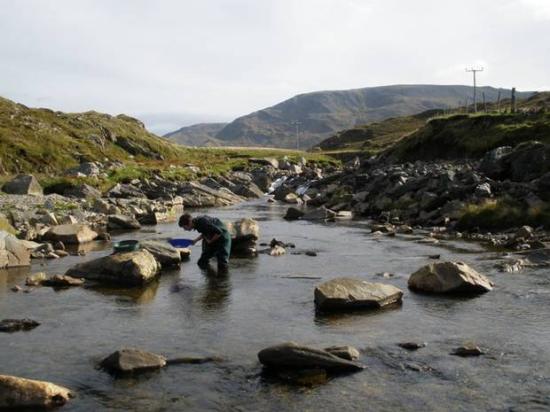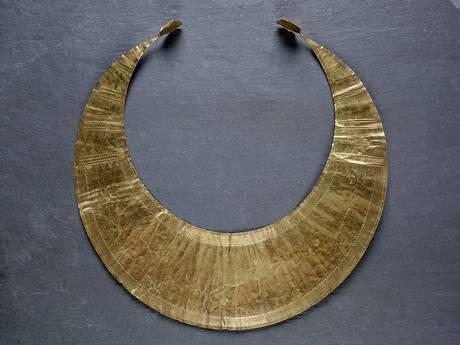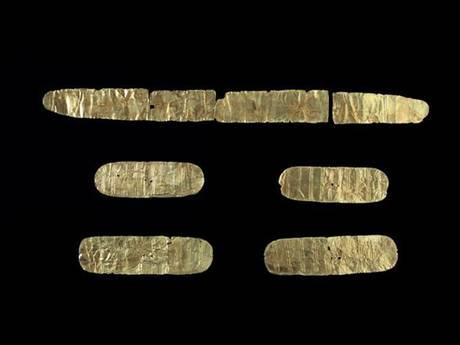David Keys
Source http://www.independent.co.uk/news/science/archaeology/news/cornwall-was-scene-of-prehistoric-gold-rush-says-new-research-10298343.html
 A detailed analysis of some of Western Europe’s most beautiful gold artefacts suggests that Cornwall was a miniature Klondyke in the Early Bronze Age
A detailed analysis of some of Western Europe’s most beautiful gold artefacts suggests that Cornwall was a miniature Klondyke in the Early Bronze Age
New archaeological research is revealing that south-west Britain was the scene of a prehistoric gold rush.
A detailed analysis of some of Western Europe’s most beautiful gold artefacts suggests that Cornwall was a miniature Klondyke in the Early Bronze Age.
Geological estimates now indicate that up to 200 kilos of gold, worth in modern terms almost £5 million, was extracted in the Early Bronze Age from Cornwall and West Devon’s rivers – mainly between the 22nd and 17th centuries BC.

Stonehenge discoveries : Detail of the decoration of the dagger handle. Shows how the studs are placed in straight lines and the heads overlap each other like fish scales University of Birmingham and David Bukach
New archaeological and metallurgical research suggests that substantial amounts were exported to Ireland, with smaller quantities probably also going to France. It also suggests that the elites of Stonehenge almost certainly likewise obtained their gold from the south-west peninsula, as may the rulers of north-west Wales, who took to wearing capes made of solid gold.

 A breast plate, top, and plaques found in Ireland (The National Museum of Ireland)
A breast plate, top, and plaques found in Ireland (The National Museum of Ireland)
The archaeologist who has carried out the metallurgical research, Dr Chris Standish of Southampton University, believes that although Cornwall’s prehistoric gold production was of considerable cultural and potentially political significance, it was, for the most part, merely a by-product of an even more important industry – tin extraction.
“The available evidence strongly suggests that in Bronze Age Cornwall and West Devon, tin wasn’t obtained through mining, but was instead extracted from the areas’ rivers, probably through panning or sophisticated damming and sluicing systems,” said Dr Standish.
“But, as well as finding tin in the sand and gravels of the streams and rivers, they also found gold,” he added.
Indeed, fine woolly sheepskins may well have been used to ‘catch’ the tiny grains of both tin and gold – in a technique similar to that which, in ancient Greek mythology, probably gave rise to the concept of the Golden Fleece.
Cornish tin was crucial to the development of the Bronze Age in Western Europe, Britain and Ireland – because in order to make bronze, the prehistoric metalworkers had to combine copper with tin.
Local rivers eroded out both tin and gold from the south-west peninsula’s exposed granite and other hard rock landscapes – from west to east, areas like Land’s End, Carnmenellis, St. Austell, Bodmin Moor and Dartmoor.
The ratio of gold to tin in the upper reaches of many of those rivers in the Early Bronze Age was potentially as high as 1:5000 – so, combining archaeological and geological evidence, it is likely that up to 200 kilos of gold were extracted during that period.
“Back in the Bronze Age, gold deposits in the headwaters of many Cornish and West Devon rivers would have been very much richer than now,” said geologist, Simon Camm, a leading expert on Cornish gold and author of the only book ever written on the subject - Gold in the Counties of Cornwall and Devon.
“It would almost certainly have attracted substantial numbers of prospectors. In an average year Bronze Age gold hunters there may well have been able to extract a total of more than 150 grams per year – with, conceivably, more than double that in a good year,” he added.
Like much of the Cornish gold, some of the tin was almost certainly ‘exported’ to Ireland where it was mixed with Irish copper to make bronze. Prior to Dr. Standish’s research, archaeologists had thought that most of the Bronze Age gold artefacts found in Ireland and Britain had been made from Irish rather than south-west British gold.
As the Bronze Age progressed, large quantities of tin were also exported to the great North Welsh copper mining area near Llandudno where it was used to make even greater quantities of bronze, especially bronze axes to help clear thousands of square miles of British forests to create more land for agriculture.
Although estimates suggest that up to 200 kilos of gold were extracted from the south-west peninsula’s streams and rivers during the Early Bronze Age, only around 270 gold artefacts from that period, totalling some eight kilos, have ever been found and recorded in Britain and Ireland. Most of the major individual pieces, that have survived through to the present day, each weigh up to 50 grams (apart from one unusually large example weighing 560 grams) and are housed mainly in museums in London, Dublin, Edinburgh, Truro (Cornwall) and Devizes (Wiltshire).
Sadly, the great majority of gold artifacts originally manufactured during that era were almost certainly repeatedly melted down over the centuries to manufacture later artifacts. Indeed some of that prehistoric Cornish gold is almost certainly still in circulation. Hundreds of other original gold artifacts probably still lie buried where they were deposited as offerings to the gods by Bronze Age priests, while many others were almost certainly unearthed by farmers and labourers over the centuries – but quietly melted down, and therefore remained unrecorded.
The most important centre for south-west British gold and tin exports in the early Bronze Age may well have been north Cornwall’s Padstow area, where the sizable estuary would have provided shelter for the merchant vessels of the period. It is one of the very few areas in Britain where a concentration of large extremely fine Early Bronze Age artifacts have been found. It is therefore also conceivable that the area is where some of the Cornish gold was transformed into spectacularly beautiful very high status ritual objects. The estuary was ideally located for trading with Ireland and Wales.
Much of the gold was beaten into thin sheets that were then cut into crescent-shaped ‘breast plates’. Recent research suggests that they may have been used as part of sun worship rituals. It’s even conceivable that some of the golden breast plates were ‘worn’ by wooden idols – as well as potentially by local religious leaders or shamans. Unlike many Bronze Age treasures, they were not normally used as grave goods for the dead – but were instead buried in peat bogs and other places as votive offerings to the gods.
Additional metallurgical tests on Bronze Age gold treasures in Britain and Europe are planned by the archaeologists – and are likely to yield further crucial information as to where prehistoric Cornwall’s golden exports went to.